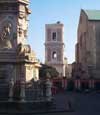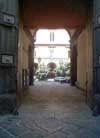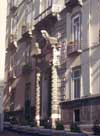|
|
|
 2nd
STAGE 2nd
STAGE
From the Church of Gesù to Piazza San Domenico
The
route that starts at piazza del Gesù Nuovo moves into a heavily
layered section of the city, particularly loved by the Neapolitan
noble classes; this was where--from the Renaissance through the
1700s--they chose to build many of their sumptuous dwellings. Across
the square, between calata Trinità Maggiore and via Domenico
Capitelli, cast a quick glance into the courtyard of the Pandola
palace and then Sanfelice di Monteforte, which faces the high spire
dedicated to the Virgin by Jesuit Father Francesco Pepe.
| |
 On the other side of the square is the wall of the Santa Chiara
monastic complex. Facing that is the entrance to the Church of Gesù
with its unmistakable stone diamond-point ashlar facade. When it
was built in 1470, it was the residence of Sanseverino, prince of
Salerno, and only later turned into a Jesuit church by Brother Giuseppe
Valeriano, who designed the Greek cross layout with three naves
embellished with a rich array of sculpture, paintings and Baroque
trappings.
On the other side of the square is the wall of the Santa Chiara
monastic complex. Facing that is the entrance to the Church of Gesù
with its unmistakable stone diamond-point ashlar facade. When it
was built in 1470, it was the residence of Sanseverino, prince of
Salerno, and only later turned into a Jesuit church by Brother Giuseppe
Valeriano, who designed the Greek cross layout with three naves
embellished with a rich array of sculpture, paintings and Baroque
trappings.
|
 Coming
now, finally, to the beginning of the decumanus, note that
the initial length of the street is now named for Benedetto Croce;
the first building on the left is, in fact, where the Neapolitan philosopher
lived for almost 40 years. The building is the Filomarino della Rocca
palace, built at the beginning of the 1400s for one Giovannello Brancaccio
and then expanded in 1512 by Giovan Francesco Di Palma for the Sanseverino
di Bisignano family. It was ultimately acquired by Tommaso Filomarino
of Rocca d'Aspide. Even the casual observer cannot fail to notice
the beautiful portal; the varied lines of the arch flow from the stone
frames of the windows that are really balconies, all the work of Ferdinando
Sanfelice. That is a mere taste of the spectacular portico that--as
in the Gravina and Santobuono palaces--surround the internal courtyard,
itself paved with volcanic brick. Just beyond that is the Capone palace,
the diplomatic seat and residence of the various Venetian envoys to
the Kingdom of Naples between 1412 and 1511; it was a donation of
Ladislao of Durazzo to the Republic of Venice and was originally surrounded
by grand courtyards and gardens that were lost in the late 1400s and
early 1500s when the prince of Bisignano, owner of the adjacent Brancaccio
building (now the Filomarino palace) aggressively expanded the boundaries
of his property. A bit farther down, on the same side of the street,
is the noteworthy stage-like portal at number 45, the residence of
prince Carafa di Roccella della Spina. It is among the most characteristic
building along the entire route, conserving the original layout from
the 1500s, including the singular stone portal of the same stamp as
the vestibule, courtyard and lovely Renaissance stairway. Coming
now, finally, to the beginning of the decumanus, note that
the initial length of the street is now named for Benedetto Croce;
the first building on the left is, in fact, where the Neapolitan philosopher
lived for almost 40 years. The building is the Filomarino della Rocca
palace, built at the beginning of the 1400s for one Giovannello Brancaccio
and then expanded in 1512 by Giovan Francesco Di Palma for the Sanseverino
di Bisignano family. It was ultimately acquired by Tommaso Filomarino
of Rocca d'Aspide. Even the casual observer cannot fail to notice
the beautiful portal; the varied lines of the arch flow from the stone
frames of the windows that are really balconies, all the work of Ferdinando
Sanfelice. That is a mere taste of the spectacular portico that--as
in the Gravina and Santobuono palaces--surround the internal courtyard,
itself paved with volcanic brick. Just beyond that is the Capone palace,
the diplomatic seat and residence of the various Venetian envoys to
the Kingdom of Naples between 1412 and 1511; it was a donation of
Ladislao of Durazzo to the Republic of Venice and was originally surrounded
by grand courtyards and gardens that were lost in the late 1400s and
early 1500s when the prince of Bisignano, owner of the adjacent Brancaccio
building (now the Filomarino palace) aggressively expanded the boundaries
of his property. A bit farther down, on the same side of the street,
is the noteworthy stage-like portal at number 45, the residence of
prince Carafa di Roccella della Spina. It is among the most characteristic
building along the entire route, conserving the original layout from
the 1500s, including the singular stone portal of the same stamp as
the vestibule, courtyard and lovely Renaissance stairway. |
 Moving
on, still in the 16th century, we find the Tufarelli palace and Foglia
palace, built in 1544 for the Pinelli family. This is the end of via
Benedetto Croce, which, a few steps away, now opens on the heart of
the ancient city: the monumental Piazza San Domenico with the beautiful
spire by Picchiatti in the center, surrounded by such notable structures
as the Dominican church , itself, and the residence of the noted De
Sangro family. In the square, other than the spire, the facades of
the Saluzzo di Corigliano palace and Sangro di Sansevero palace can
be seen. Also, immediately on the left, on the west side of the square
is the Antonello Petrucci palace, built in Gothic style for the Del
Balzo family at the beginning of the 1400s and rebuilt after the earthquake
of 1688 as well as after the one at the beginning of the 1800s. Among
the few remaining original elements of the structure are the lowered
arch, the typically Catalonian gallery above the courtyard, the marble
portal with classical motifs, and the Durazzo-influenced style of
the stairway leading to the apartments. Beside that building on the
right-hand side stands the lovely De Sangro di Cascalenda palace with
a beautiful courtyard attributed to Vanvitelli. Moving
on, still in the 16th century, we find the Tufarelli palace and Foglia
palace, built in 1544 for the Pinelli family. This is the end of via
Benedetto Croce, which, a few steps away, now opens on the heart of
the ancient city: the monumental Piazza San Domenico with the beautiful
spire by Picchiatti in the center, surrounded by such notable structures
as the Dominican church , itself, and the residence of the noted De
Sangro family. In the square, other than the spire, the facades of
the Saluzzo di Corigliano palace and Sangro di Sansevero palace can
be seen. Also, immediately on the left, on the west side of the square
is the Antonello Petrucci palace, built in Gothic style for the Del
Balzo family at the beginning of the 1400s and rebuilt after the earthquake
of 1688 as well as after the one at the beginning of the 1800s. Among
the few remaining original elements of the structure are the lowered
arch, the typically Catalonian gallery above the courtyard, the marble
portal with classical motifs, and the Durazzo-influenced style of
the stairway leading to the apartments. Beside that building on the
right-hand side stands the lovely De Sangro di Cascalenda palace with
a beautiful courtyard attributed to Vanvitelli. |
 On the east side of the square, directly across from piazza San Angelo
a Nilo, the Saluzzo di Corigliano palace stands on the corner of via
San Domenico Maggiore and Spaccanapoli. It is a grand residence from
the 1500s built by Giovanni Donadio (called "il Mormando") for the
duke of Vietri Giovanni de Sangro and his wife Andreana Dentice. It
currently houses lecture halls and classrooms for the Orientale University
of Naples. The Raimondo De Sangro di Sansevero palace is directly
adjacent and is the most famous and perhaps most important building
in the square. Prince De Sangro di Sansevero was well-known in the
1700s for his mechanical inventions and experiments in alchemy. The
building was erected in the first half of the 1500s to a design by
Merliano da Nola for don Paolo de Sangro. The internal courtyard is
accessed via a large entrance way flanked by allegorical scenes in
bas- relief by Giuseppe Sammartino, whose famous statue of the Veiled
Christ is on display in the nearby family chapel.
On the east side of the square, directly across from piazza San Angelo
a Nilo, the Saluzzo di Corigliano palace stands on the corner of via
San Domenico Maggiore and Spaccanapoli. It is a grand residence from
the 1500s built by Giovanni Donadio (called "il Mormando") for the
duke of Vietri Giovanni de Sangro and his wife Andreana Dentice. It
currently houses lecture halls and classrooms for the Orientale University
of Naples. The Raimondo De Sangro di Sansevero palace is directly
adjacent and is the most famous and perhaps most important building
in the square. Prince De Sangro di Sansevero was well-known in the
1700s for his mechanical inventions and experiments in alchemy. The
building was erected in the first half of the 1500s to a design by
Merliano da Nola for don Paolo de Sangro. The internal courtyard is
accessed via a large entrance way flanked by allegorical scenes in
bas- relief by Giuseppe Sammartino, whose famous statue of the Veiled
Christ is on display in the nearby family chapel. |
| Previous
page - 1st Stage |
Next
page - 3rd Stage |
Photos:
Jeff Matthews |
|
|
